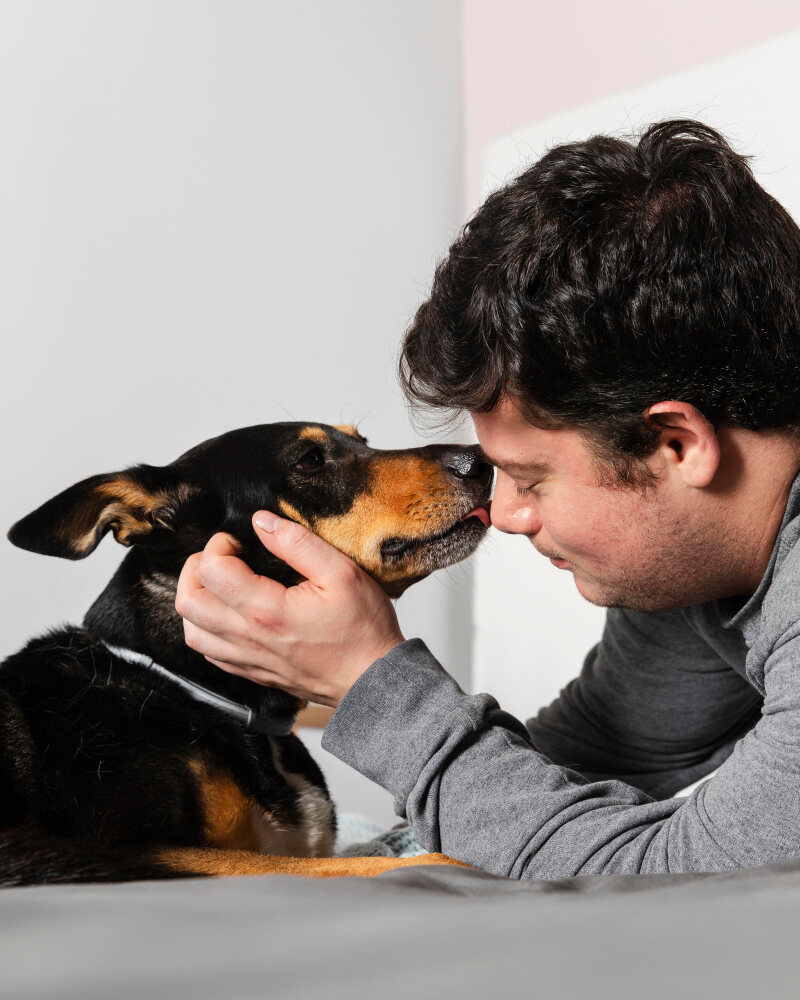How to Hold a Puppy – Dos & Don’ts

Picking up a puppy might seem simple, but improper handling can lead to physical harm or stress, leaving your furry friend anxious and uncomfortable. This not only impacts their trust in you but can also cause long-term issues with bonding. The good news? Learning how to hold a puppy correctly ensures their safety, comfort, and happiness. In this guide, we’ll walk you through expert tips and techniques to master this essential skill.
Why Proper Handling Matters
Properly holding a puppy is essential for their physical safety and emotional well-being. Puppies are delicate, with soft bones and developing muscles that can be easily injured by incorrect handling. Ensuring proper support prevents strain on their fragile bodies and reduces the risk of accidental harm.
Beyond physical safety, handling impacts a puppy’s trust and comfort. Improper techniques can make them anxious, fearful, or resistant to being picked up in the future. When done correctly, however, holding creates a sense of security and strengthens the bond between you and your new furry friend.
How to Hold a Puppy? Step-by-Step Guide
Holding a puppy correctly starts with a calm and gentle approach. Move slowly to avoid startling them, and speak softly to make them feel at ease. Observe their body language for any signs of discomfort, like squirming or whining, before proceeding.
To lift the puppy, place one hand securely under their chest near their front legs. Use your other hand to support their hindquarters, ensuring their body is fully supported. Lift slowly and smoothly, keeping the puppy close to your body to make them feel safe and stable.
While holding, keep the puppy’s body upright and avoid letting their limbs dangle. Adjust your grip as needed to prevent slipping, but always prioritize their comfort and security. Proper technique not only ensures their safety but also strengthens your bond with your furry friend.
Puppy Handling Guidelines by Age
Your strategy for picking up a puppy should always include staying calm and confident and distributing their weight evenly, but Dr. Fernandez-Lopez has some tips for the various ages and stages of puppyhood.
| Age Group | Handling Tips | Key Considerations |
| 0–4 Weeks (Neonatal Stage) | Handle very minimally and gently. Always support the entire body, especially the head and neck. | Puppies are fragile and rely entirely on their mother for warmth and nutrition. Avoid overhandling. |
| 4–8 Weeks (Transitional Stage) | Gently hold with one hand under the chest and one under the hindquarters. Allow short periods of human interaction. | Puppies start exploring but are still delicate. Avoid loud noises and sudden movements. |
| 8–12 Weeks (Socialization Stage) | Support their body while holding, ensuring their feet aren’t dangling. Encourage positive interaction. | This is a crucial bonding period; avoid scaring them and prioritize gentle handling. |
| 3–6 Months (Juvenile Stage) | Firmly hold with both hands supporting the chest and hindquarters. Allow them to wriggle safely if playful. | Teething occurs during this period, so they might nip while being held. |
| 6–12 Months (Adolescence) | Use both arms to lift larger breeds. Always hold close to your body for stability. | Puppies are energetic and might resist handling; ensure proper support to prevent injury. |
Puppy Handling Guidelines by Breed
Because dog breeds differ in size, temperament, and physical needs, you may have to slightly alter your strategy based on your puppy’s characteristics.
| Breed Type | Handling Tips | Key Considerations |
| Small Breeds | Gently support their chest with one hand and their hindquarters with the other. | Fragile bones; avoid squeezing. Examples: Chihuahua, Pomeranian. |
| Medium Breeds | Use both hands for support—one under the chest and one under the abdomen. | Moderate strength needed; may squirm. Examples: Beagle, Cocker Spaniel. |
| Large Breeds | Use one arm under the chest and the other under the hindquarters, holding them close to your body for stability. | Growing joints are sensitive; avoid unnecessary strain. Examples: Labrador Retriever, Golden Retriever. |
| Giant Breeds | Use both arms: one under the chest and one under the belly or hind legs; may require help as they grow quickly. | Heavy pups may need two people for lifting safely. Examples: Great Dane, Saint Bernard. |
| Toy Breeds | Cradle them close to your chest for warmth and security, supporting the head and body. | Extremely delicate; prone to injury if mishandled. Examples: Maltese, Yorkshire Terrier. |
| Brachycephalic Breeds | Avoid pressure on the chest; gently scoop them up, keeping the head elevated for easier breathing. | Short snouts can cause breathing issues if held improperly. Examples: Pug, French Bulldog. |
| Herding Breeds | Hold securely to prevent wriggling; use a firm grip under the chest and hindquarters. | Energetic and alert; may resist handling. Examples: Border Collie, Australian Shepherd. |
| Hound Breeds | Lift carefully with both hands; ensure even support to their long backs. | Long-bodied breeds like Dachshunds need extra back support to prevent injury. |
| Terrier Breeds | Hold firmly but gently; these puppies tend to be wiggly and energetic. | Can be feisty; ensure a secure grip. Examples: Jack Russell Terrier, Scottish Terrier. |
| Sporting Breeds | Use both hands to support chest and hind legs, keeping them close to your body. | Naturally active and playful; may squirm. Examples: Spaniels, Retrievers. |
| Working Breeds | Hold firmly with one hand supporting the chest and the other the hind legs. | Strong and robust even as puppies; ensure proper support. Examples: Boxer, Rottweiler. |
| Sighthounds | Use one hand under the chest and the other under the abdomen or hindquarters. | Thin, long legs and fragile frame despite size. Examples: Greyhound, Whippet. |
How to Pick Up a Puppy: Dos & Don’ts
Holding a puppy may seem simple, but knowing the right techniques is essential for their safety and comfort. Proper handling helps avoid injuries and builds trust, making your puppy feel secure in your care. On the other hand, improper handling can lead to physical strain, emotional distress, and even long-term aversion to being held. By following some basic guidelines, you can ensure your puppy feels safe and loved. Here’s a comprehensive look at what to do and avoid when holding your furry friend.
Dos – The Proper Way to Pick Up a Puppy
- Support Their Body Properly: Always place one hand under the chest and the other under the hindquarters to provide balanced support. This prevents strain on their developing muscles and bones.
- Keep Movements Gentle: Lift the puppy slowly and avoid sudden movements to make them feel safe and comfortable. Cradle them close to your body to provide warmth and security.
- Pay Attention to Body Language: Look for signs of discomfort, such as squirming or whining, and adjust your hold if necessary. A calm puppy is a comfortable puppy.
Don’ts – The Wrong Way to Pick Up a Puppy
- Never Hold by Limbs or Scruff: Picking up a puppy by their legs, tail, or scruff can cause pain or injury. Puppies lack the muscle strength to support their weight this way.
- Avoid Squeezing Too Tightly: Holding a puppy too firmly can make them feel threatened or cause breathing difficulties. Ensure your grip is secure but gentle.
- Don’t Ignore Discomfort: If the puppy struggles, don’t force them to stay in your arms. Place them back on the ground and try again later to avoid fostering fear or anxiety.
By following these guidelines, you ensure your puppy’s safety while building a trusting relationship. Proper handling promotes confidence and comfort for both you and your furry friend.
Common Mistakes and How to Fix Them
One common mistake is picking up a puppy by their limbs or scruff, which can cause pain and injuries. Instead, always use both hands to fully support their body, with one under their chest and the other under their hindquarters. This distributes their weight evenly and keeps them comfortable.
Another error is holding a puppy too tightly, which can make them feel trapped and anxious. A firm but gentle grip is key to providing security without causing discomfort. Keep their body close to yours to offer warmth and a sense of protection.
Many people overlook signs of stress in puppies, such as squirming, whining, or stiffening. Ignoring these signals can damage trust and make future handling difficult. To fix this, always observe your puppy’s body language and adjust your approach to ensure they feel safe and calm.
Lastly, lifting a puppy abruptly or with jerky movements can startle or harm them. Use slow, steady motions when picking them up or setting them down. This not only prevents injury but also builds their confidence in being handled.
Conclusion
Holding a puppy correctly is essential for both their safety and your bond with them. Proper handling ensures that your puppy feels secure, builds trust, and prevents physical harm. By using gentle, supportive techniques, you can avoid common mistakes and promote a positive experience for both you and your puppy. With these tips, you’ll not only keep your puppy safe but also strengthen your relationship, making every cuddle a joyful and reassuring moment.
Frequently Asked Questions
How long can I hold a puppy at a time?
Holding a puppy for extended periods can make them restless or uncomfortable, especially if they are young and still adapting to human interaction. A few minutes at a time is ideal, depending on the puppy’s comfort level and behavior. Always monitor for signs of distress, such as squirming or whining, and give them breaks to move around and explore their surroundings.
Is it safe to hold a puppy while standing?
Yes, it can be safe to hold a puppy while standing as long as you use proper technique. Make sure to fully support their body with both hands and keep them close to your chest to minimize the risk of slipping. Avoid standing on uneven surfaces or engaging in sudden movements, as these increase the chances of an accidental fall, which can harm the puppy.
Can I hold a puppy immediately after feeding them?
It’s best to wait at least 20-30 minutes after feeding before holding your puppy. Holding them too soon after eating can cause discomfort or digestive issues like vomiting, especially if they are lifted in a way that compresses their abdomen. Allow your puppy some time to rest and digest their food before picking them up.
How can I get my puppy used to being held?
To get your puppy comfortable with being held, start by handling them gently for short periods. Use a calm tone and reward them with treats or praise to create positive associations. Gradually increase the duration and frequency of holding as they become more relaxed. This process helps build trust and ensures they feel safe when being picked up.
Is there a right age to start holding a puppy?
You can start holding a puppy as soon as they are a few days old, but extra care is needed for newborns. Their bones and muscles are extremely fragile, and they rely heavily on their mother during this time. For older puppies, begin with gentle handling, ensuring proper support for their developing bodies. Always consider their comfort level and avoid overhandling them.
Tags
What do you think?
Related Articles

How to Care for Newborn Puppies: A Complete Guide
Caring for newborn puppies can feel overwhelming, especially when their survival depends on meticulous attention. Without proper feeding, warmth, and hygiene, these fragile pups are

Why Puppies Won’t Eat & What to Do About it?
As a pet parent, it’s distressing to see your puppy avoid meals. A lack of appetite can signal stress, teething pain, or an underlying issue.

How to Have Thanksgiving Dinner Without a Dog Begging at the Table
Thanksgiving is a time for family, food, and togetherness. However, a dog begging at the table can disrupt this special meal. Thankfully, with a bit
